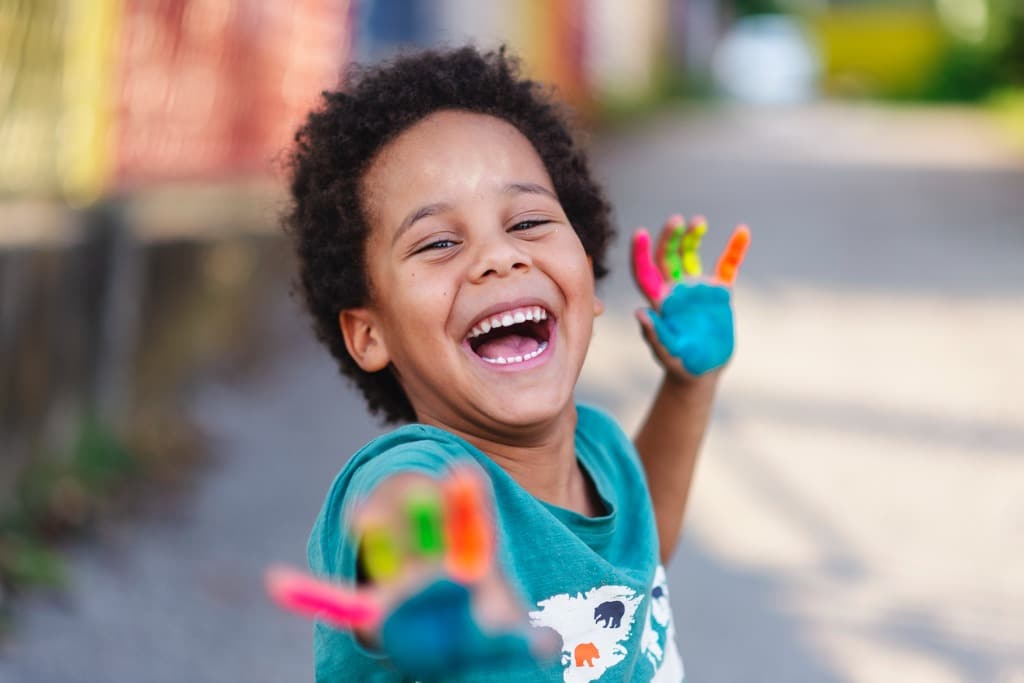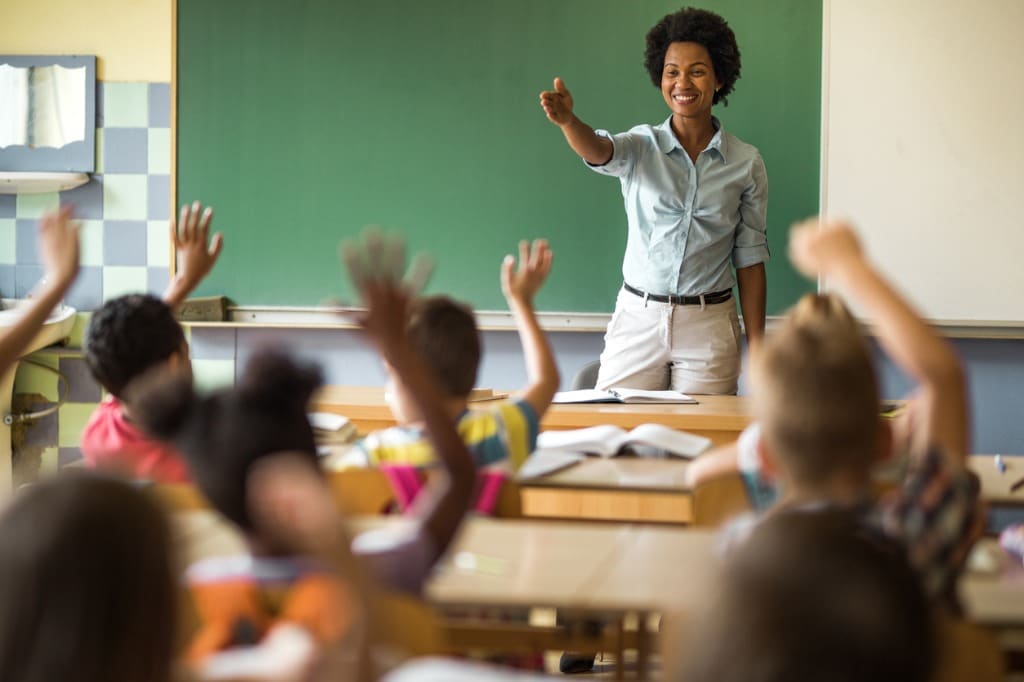
Self-confidence is one of those beautiful, elusive things that can only be taught to students indirectly. Just as we tell our kids to “show, not tell” when writing, simply telling them to believe in themselves isn’t enough.
It’s up to us to show them how much they are truly capable of by giving them the means to express themselves fully. These confidence-building classroom strategies and activities offer fun, creative outlets for your elementary students that will help them view themselves more positively.
Praise Students for Their Intellectual Contributions
Creative writing is critical to young students because it allows them to develop their descriptive writing skills without worrying about giving a wrong answer. Supporting your students’ ideas and stimulating their writing will be the force that drives them to become confident writers in the future.
It’s natural to focus on the mechanics of sentence structure or punctuation. However, depending on your students’ ages and skill levels, it may be beneficial to opt for a more objective way to reinforce writing fundamentals.
Don’t just focus on the technicalities. Children need to hear that they are good writers and that their writing is important and valid. Try to acknowledge the intellectual contributions, such as story structure or creative topic ideation, that they have made in their writing. It is important to remind children that they are doing well and their work is appreciated.
There is, of course, a need to reinforce formal grammar instruction. However, you also need to keep in mind that a student’s quality of work doesn’t solely depend on grammar, capitalization and punctuation. After all, these students are still learning, and their writing is a work in progress.
The question now is, how can you point out spelling and punctuation errors without making students feel defeated?
Review Student Writing in an Encouraging Way
Mistakes are a healthy part of learning and life. Make sure you tell your students that even the best writers have to go back and correct their mistakes. Reiterate that correcting errors is a natural part of the writing process at every level.
You should use your classbook project as an opportunity to teach students about draft editing and proofreading in a way that is both constructive and encouraging. Here is how you can correct student mistakes without negatively affecting their confidence.
1. Start by Praising Their Accomplishments
Your students worked hard on their writing, and you should acknowledge that right off the bat. Students need to feel good about their accomplishments before they can take constructive criticism.
2. Say Something Positive About Their Work
This is probably the most crucial step on this list. Start by saying something positive about what the student wrote. This could be something like “you did a great job describing what your house looks like” or “your story is hilarious, and your spelling is awesome.”
It doesn’t have to be a full-blown 20-minute compliment session, but this helps put the student’s mind in a positive place before you tell them what they can improve on.
3. Point Out What Needs Improvement then Set Attainable Goals
It is essential to show students how they can improve their writing, but you can’t stop there. You should plan with the student and set a goal that helps them become a stronger writer.
4. Highlight Their Strengths and Encourage Them to Build on Those Strengths
Ending on a positive note is just as important as starting on one when reviewing a student’s work. Find something that stands out about what they wrote and tell them to improve that skill.
Let’s say that a student uses a writing strategy, such as creating a visual picture with their words. Have them expand on that by having them explain to you what they want the reader to see. If you have a student who has astounding spelling skills, encourage them to use more challenging words and phrases.
5. Utilize Peer Reviews
Once students have written and edited their book pages, prompts, poems or essays, have them read what they wrote in front of the class. After they present their work, have other students tell the presenter what they liked about their writing. This will reinforce to students that their peers respect and enjoy what they have written.
The key here is that all comments are positive. There is a time and a place for peer editing and constructive criticism, but this activity aims to build student self-esteem.
If you are afraid that your students do not have the attention span to sit through this activity or that there may be a lack of participation, you can have your students trade their work with a partner and tell each other what they liked about their partner’s writing. The best thing about peer reviews is that they can be used at any grade level to help build student confidence.
Are you Enjoying this Content?
How to Build Student Confidence by Creating a Class Book
Giving students the freedom to write about what they want will help them realize that writing isn’t just grammar exercises and spelling tests. It’s a way to express their thoughts and feelings and build confidence and self-esteem.
 It’s essential for you, as a teacher, to guide your students through their writing journey. However, you should also enable your students to learn on their own and from one another.
It’s essential for you, as a teacher, to guide your students through their writing journey. However, you should also enable your students to learn on their own and from one another.
Writing allows children to leave their comfort zones, express their emotions and feel empowered. They will become more independent and confident as they write and contribute to a classbook.
Publishing a classbook shows your students that their work is valued and worthy of being captured in a physical book, just like the ones that they have at home. This will help build their self-esteem as writers and introduce them to the creative writing process.
After students have written and edited the prompts below, you can turn their writing into a class book! Publishing a class book gives students physical evidence of their work that will last a lifetime.
Activity #1: Positive Self-Portrait Collage
Vision boards allow us to envision a future and more effectively work towards that future. Similarly, this confidence-building activity helps your students recognize their best qualities and strengths.
Ask your students to bring in (or you can provide them with) old or unwanted magazines and newspapers that can be cut up and used as raw material for their art.
The goal is to create a “self-portrait” collage using only words and images that reflect positive things about themselves. These can include things they love, things they are good at and the things they like the most about themselves.
PROJECT IDEA
Once your students finish creating their collages, ask them to write a response describing themselves in the third person, incorporating as many elements from their self-portraits as possible. Both their collages and descriptions should serve as reflections of their best selves.
Then, publish their written and visual portraits in a one-of-a-kind classbook that they can look back on anytime they need a little extra help believing in themselves.
- IMPORTANT! We recommend using glue sticks, not tape, to create collages! Using tape will cause shadows on your published classbook pages. Alternatively, if your students are computer-savvy, they can publish their classbooks digitally instead, using clipart and photos.
Activity #2: Be Your Own Hero
We all look up to our heroes. Kids, in particular, often choose fictional protagonists as their heroes, idolizing people they see as strong (like Superman or Wonder Woman) and brave (like Disney’s Merida or the legendary King Arthur). However, we believe you should always be able to see yourself in the leading role of your own life.
You can bolster your students’ confidence by encouraging them to stand in the spotlight and write their own stories starring themselves as the hero. Whether it’s a high-fantasy epic, a superhero story or something else is entirely up to them. The one rule is, there can be no tragedies!
There’s nothing like saving the day—even if only in a story—to help build self-confidence and promote a positive self-image.
PROJECT IDEA
Ask your students to create illustrations to match their stories. Make sure to schedule time for your students to revise their work. Create a collaborative drawing (or take a class photo) of everyone dressed up as their heroic selves to use as a cover image and publish their writing and illustrations in a professionally bound and published classbook.
When your published books arrive, be sure to have your students read their stories aloud, either in class or during a themed publishing party, to reaffirm the message of their stories—that they can be their own heroes.
Activity #3: Areas of Expertise
Everyone is good at something. One great confidence-building activity for elementary students is to let them show off something they do well or know a lot about by playing teacher for the day.
Ask your students to each choose a topic (any topic, as long as it’s appropriate for school!) that they consider themselves to be experts at. Have them prepare short lectures or lesson plans around their topics to present to the class (Here’s a tip! You may want to use a sign-up sheet to avoid duplicate lessons).
Even students who shy away from public speaking may find this activity more engaging than typical classroom presentation projects simply because the topics are so much fun. I’ve seen students discuss everything from yo-yo techniques to video games to performing “The Perfect Cast” dance move from A Goofy Movie!
PROJECT IDEA
In addition to their presentations, ask your students to write a short nonfiction piece about how they became experts in their chosen subject matter. What drew them to this topic? What makes them an expert now?
Have them draw or provide pictures of themselves doing something related to their topics. Publish their writing and the accompanying images in a classbook that’s sure to be as entertaining as it is educational! Here’s a tip! Make sure to use glue sticks, not tape, to affix any photos to the pages of your book.
A Writing Activity That Builds Self-Esteem
Instilling confidence in young students is a worthwhile challenge. Cultivating confidence in your students can significantly impact their growth as a writer and as a person. For more collaborative project ideas and creative writing resources, be sure to check out our online Teacher’s Lounge and sign up for your free classbook publishing kit!






